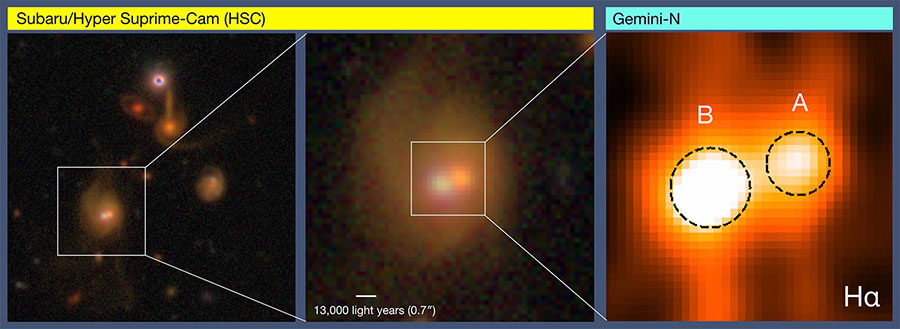
In our dynamically evolving Universe, galaxies occasionally experience collisions and mergers with a neighboring galaxy. These events can be dramatic, causing the birth of new stars, and the rapid feeding of the supermassive black hole that resides in each galaxy. It's understood that these enormous black holes have masses millions to billions of times larger than our Sun and exist in the center of all massive galaxies. As material swirls around the black hole, it is heated to high temperatures, releasing so much light that it can outshine its host galaxy. Astronomers refer to this phenomenon as a quasar.
Simulations of galaxy mergers demonstrate that sometimes quasar activity occurs at the centers of both galaxies concurrently as they undergo a cosmic dance. Such a merging pair will arise as a pair of luminous "dual" quasars. While astronomers have previously found a modest number of luminous quasar pairs, they are rare. Finding them requires observations with both the resolution to separate the light from two quasars in close proximity and coverage across a wide enough area of the sky to catch these rare events by random chance.
To overcome these challenges, astronomers are taking advantage of a high-resolution and wide-area survey of the sky, using Hyper Suprime-Cam (HSC) on the Subaru Telescope, to search for dual quasars. "To make our job easier, we started by looking at the 34,476 known quasars from the Sloan Digital Sky Survey with HSC imaging data to identify those having two (or more) distinct centers," explains lead researcher John Silverman, of the Kavli Institute for the Physics and Mathematics of the Universe. "Honestly, we didn't start out looking for dual quasars. We were examining images of these luminous quasars to determine which type of galaxies they preferred to reside in when we started to see cases with two optical sources in their centers where we only expected one."
After a slight modification of their automated analysis tools, the team identified 421 promising cases. However, there was still the chance that many of these were not bona-fide dual quasars but rather chance projections such as due to stars in our own galaxy. Confirmation required detailed analysis of the light from the candidates to search for definitive signs of two distinct quasars. Using the Keck-I and Gemini-North telescopes on the summit of Maunakea in Hawai'i, Silverman and his team identified three dual quasars, two previously unknown: each object in the pair showed the signature of gas moving at thousands of kilometers per second under the influence of a supermassive black hole. The figure shows a newly-discovered dual quasar. The mass of each black hole is around 100 million times the mass of our Sun. The companion is redder than its partner, perhaps indicating that it is partially hidden behind other material left over from the collision between the host galaxies.
Based on these observations, the team estimates that 0.3% of all quasars actually have two supermassive black holes in the quasar phase. The low fraction exemplifies their rarity and the reason so few were found in past searches. However, Shenli Tang, a graduate student at the University of Tokyo and a project member, points out, "In spite of their rarity, they represent an important stage in the evolution of galaxies, where the central giant is awakened, gaining mass, and potentially impacting the growth of its host galaxy." These results demonstrate the promise of wide-area imaging to detect dual quasars for the study of the growth of galaxies and their supermassive black holes. These three detections are just the beginning of the results to come with HSC on the Subaru Telescope, as the team obtains spectra of many more dual quasar candidates.
These results appeared as J.D. Silverman et al. "Dual Supermassive Black Holes at Close Separation Revealed by the Hyper Suprime-Cam Subaru Strategic Program" in The Astrophysicl Journal on August 26, 2020.






